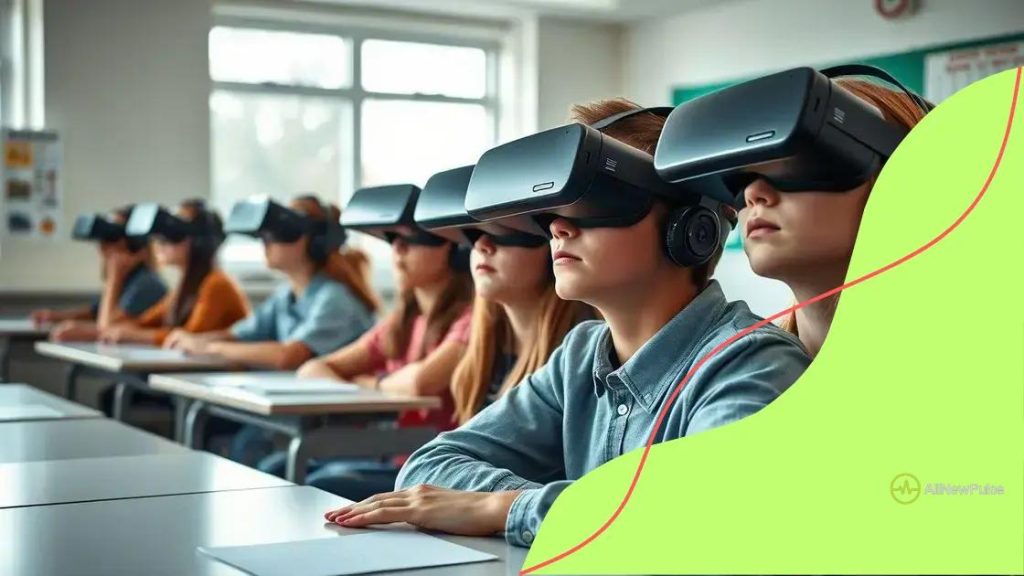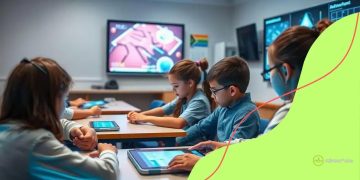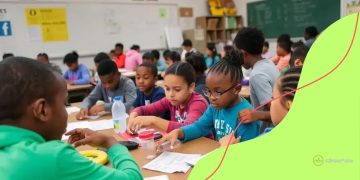Integration of virtual reality in educational settings: a revolution

The integration of virtual reality in educational settings enhances student engagement, understanding of complex concepts, and supports diverse learning styles, while addressing accessibility and budget challenges.
Integration of virtual reality in educational settings is transforming how students learn and interact with content. Have you ever imagined stepping into a history lesson or exploring the human body from the inside? That’s the power of VR in education!
Understanding virtual reality in education
Understanding virtual reality in education is essential for teachers and students alike. It opens up new possibilities for immersing learners in interactive environments that enhance understanding and engagement.
What is virtual reality?
Virtual reality is a simulated environment that can be similar to or completely different from the real world. It uses technology to create interactive experiences where users can engage with visual and auditory stimuli in a way that feels real.
Benefits of virtual reality in learning
Incorporating virtual reality into lessons can provide significant benefits, such as:
- Enhancing student engagement by making lessons more interactive.
- Helping learners grasp complex concepts through visual simulations.
- Allowing students to explore scenarios that would be impossible or impractical in real life.
When students participate in virtual reality, they often remember information better. This is because they can explore topics in a hands-on way. Imagine a science class where students can walk through the human body or a history lesson that lets them visit ancient sites. These experiences make learning memorable and exciting.
How does virtual reality work in the classroom?
In a classroom setting, teachers can use virtual reality headsets connected to software designed for education. These platforms often include a range of subjects and activities suitable for various age groups. By simply putting on a headset, students can enter a different world and participate in lessons that would otherwise be hard to visualize.
Furthermore, virtual reality tools encourage collaboration among students. They can work together to solve problems or complete tasks in a shared virtual space. This teamwork can enhance social skills and promote deeper understanding of the material.
As technology evolves, the possibilities for virtual reality in education will only expand. Educators must stay informed about these trends to maximize learning opportunities.
Benefits of using virtual reality in classrooms
Using virtual reality in classrooms offers numerous advantages for both teachers and students. By integrating this technology, learning becomes more engaging and effective.
Enhanced engagement
Virtual reality captures students’ attention like nothing else. When students wear headsets and interact with 3D environments, they become part of the lesson. This immersion leads to deeper interest in various subjects.
Improved understanding of complex concepts
Topics that can be tough to grasp, such as anatomy or physics, become more accessible with virtual reality. For instance, students can visualize the human heart’s structure while exploring its functions. This hands-on learning helps solidify understanding.
- Students can interact directly with models, promoting active learning.
- Visualizing abstract ideas makes them easier to comprehend.
- Learning through exploration encourages curiosity and motivation.
Virtual reality also allows for experiential learning without the limitations of the physical classroom. For example, students can take virtual trips to historical sites, experiencing cultures and events firsthand.
Accessibility for diverse learning styles
Every student has a unique way of learning. Virtual reality caters to various styles by offering visual, auditory, and kinesthetic experiences. Students who struggle with traditional learning methods often find virtual reality more engaging.
Moreover, this technology helps students with special needs by creating adjustable environments that can be tailored to their learning requirements. This inclusivity fosters a sense of belonging and ensures no student is left behind.
As virtual reality technology evolves, its potential for transforming education will keep growing. Teachers must embrace these changes to provide their students with modern, effective learning experiences.
Challenges of integrating virtual reality

Integrating virtual reality into the classroom presents several challenges that educators must navigate. These hurdles often concern costs, training, and accessibility for all students.
Cost of technology
One significant barrier to implementing virtual reality in education is the cost. High-quality VR headsets and the necessary software can be expensive. Many schools operate on tight budgets, making it hard to justify such investments.
Teacher training and support
Another challenge involves the need for adequate training for educators. Teachers must understand how to use virtual reality tools effectively to enhance learning. Without proper training, the technology might not be used to its full potential.
- Professional development programs should include VR training.
- Teachers need time to explore and create engaging VR lessons.
- Support from tech specialists can ease the transition into using VR.
Moreover, some educators may feel overwhelmed by new technology. Ongoing support and resources are essential for building confidence in using virtual reality in their teaching practices.
Accessibility issues
Accessibility is a crucial factor in ensuring all students benefit from virtual reality. Not every student has equal access to technology at home, which can create disparities in learning.
Additionally, students with special needs may require customized VR experiences to participate fully. It is essential for schools to consider these factors when integrating virtual reality into their programs. Ensuring inclusive VR experiences promotes equity in education.
As challenges arise, finding solutions becomes vital. By addressing these obstacles, educators can create a more effective and engaging learning environment with virtual reality.
Case studies of successful implementation
Case studies of successful virtual reality implementation in education highlight the many ways this technology can enhance learning experiences. Various schools and institutions have utilized VR to improve engagement and comprehension.
1. Virtual Reality in Medical Training
One prominent example is using virtual reality in medical training programs. Institutions like medical schools have introduced VR simulations to teach students about complex procedures. This hands-on approach allows learners to practice surgery skills in a risk-free environment.
2. Virtual Field Trips
Some schools have successfully implemented virtual reality for field trips. For instance, student groups can “visit” locations like the Louvre or the Great Barrier Reef without leaving their classrooms. This type of engagement makes learning more interactive and memorable.
- Students report higher excitement levels when learning through VR.
- Teachers can reinforce subjects by connecting real-world experiences with classroom learning.
- Virtual trips often lead to more discussions and questions from students.
These experiences allow students to craft a deeper understanding of different cultures and subjects while actively involving them in the educational process.
3. Enhancing STEM Education
Another successful case is the use of virtual reality in science, technology, engineering, and mathematics (STEM) education. Schools have turned to VR to teach physics through interactive simulations. Students can manipulate variables and directly see their effects in real time.
Teachers noted significant improvements in students’ grasp of challenging concepts. This hands-on approach can spur excitement about pursuing careers in STEM fields.
By looking at these case studies, educators can see the potential benefits of virtual reality in creating engaging, effective learning environments. Each success story adds to the growing body of evidence supporting the integration of VR in education.
Future trends in virtual reality for education
The future trends in virtual reality for education are exciting and full of potential. As technology continues to evolve, we can expect significant advancements that will enhance how students learn.
Increased Accessibility
One major trend is the push towards making virtual reality more accessible. Companies are developing affordable VR headsets, making it possible for more schools to adopt this technology. With lower costs, more students can experience immersive learning.
Augmented Reality Integration
Another emerging trend is the integration of augmented reality (AR) with virtual reality. This combination allows for blended learning experiences where students can interact with both the real world and virtual elements. Imagine a biology lesson where students can see human anatomy models overlaying their desks.
- AR apps can provide instant information as students point their devices at objects.
- This method creates engaging, hands-on learning experiences.
- Combining VR and AR can cater to visual and kinesthetic learners.
Such innovations are likely to enhance engagement, leading to improved academic performance.
Curriculum Development
As more educators recognize the benefits of virtual reality, we can expect to see more developed and tailored curriculums that integrate this technology. Educational institutions will create specific VR courses, focusing on a range of subjects from history to advanced sciences.
This curriculum will offer students opportunities to engage in experiences ranging from exploring ancient civilizations to conducting virtual science experiments. These developments can revolutionize traditional teaching methods.
Overall, the future of virtual reality in education is bright. With advancements in technology and curriculum design, students worldwide will benefit from immersive and engaging learning experiences.
In conclusion, the integration of virtual reality in education opens up exciting possibilities for enhancing learning experiences. As technology evolves, we are witnessing improved accessibility, innovative curriculum development, and unique teaching methods that captivate students’ interests. By using virtual reality, educators can create immersive environments that promote engagement and understanding, helping students connect more deeply with the material. The future looks promising, and the potential for VR to transform education is vast.
FAQ – Frequently Asked Questions about Virtual Reality in Education
What are the main benefits of using virtual reality in education?
The main benefits include enhanced engagement, improved understanding of complex concepts, and support for diverse learning styles.
How can virtual reality improve student engagement?
Virtual reality creates immersive environments that capture students’ attention and make learning more interactive and enjoyable.
What challenges exist when integrating virtual reality in schools?
Challenges include high costs, the need for teacher training, and ensuring accessibility for all students.
What trends are shaping the future of virtual reality in education?
Future trends include increased accessibility, integration with augmented reality, and more tailored curriculums that focus on immersive learning experiences.





